

Discover more from Castles in the Sky
Living the Questions, Reading the Clown-Arounds
Embracing the Trivial in a World Obsessed with Takeaways
This essay is on the long side with a lot of pictures so you should probably open it on Substack on the web or in the Substack app.
Every night and most afternoons for the last three weeks, I have sat with my two-and-a-half-year-old daughter and read her all five Clown-Around books two times before she goes to sleep. This forty-five-minute ritual is the only routine that gets the job done.
It’s a ritual that naturally evolved as her mother and I struggled to get her to calm down and lie in her crib at bedtime. The fussing around bedtime has become minimal, from a thunderstorm to a sprinkle. She not only tolerates reading these books but looks forward to them.
But this is not an essay about bedtime or parenting, it’s an essay about The Clown-Arounds and what they’ve taught me about curiosity, literature, and the value of engaging deeply with things that seem trivial.
Introducing The Clown-Arounds
Bruce Lee said, “I fear not the man who has practiced 10,000 kicks once, but I fear the man who has practiced one kick 10,000 times.” I don’t know if I’ve read The Clown-Arounds ten thousand times, but it feels like it. And I’ve got some opinions!
You see, I’ve googled “clown-arounds reddit” and a dozen other similar things to find out where people are talking about these masterpieces online, but I can’t find anything. I can find the books for sale, as they sold well for children’s books in the early 1980s, but nobody is talking about the high art that author Joanna Cole and illustrator Jerry Smath have put together.
You might recognize Cole’s name as she was the author of over 250 children’s books, most notably the Magic School Bus series. Jerry Smath was a prolific illustrator who also wrote the But No Elephants series. Together, they made five Clown-Around books. In order of publication, they are:
The Clown-Arounds (1981)
The Clown-Arounds Have a Party (1982)
Get Well, Clown-Arounds! (1982)
The Clown-Arounds Go On Vacation (1983)
Sweet Dreams, Clown-Arounds! (1985)
This is how I would rank them in order of quality, from worst to best:
The Clown-Arounds Go On Vacation (1983)
Sweet Dreams, Clown-Arounds! (1985)
Get Well, Clown-Arounds! (1982)
The Clown-Arounds Have a Party (1982)
The Clown-Arounds (1981)
Counting down from worst to best, here are thoughts on each Clown-Around book with accompanying pictures when needed.
#5 | The Clown-Arounds
When I choose what to read to my daughter, I only ask one question, “does my daughter like it?” But when I evaluate a children’s book for myself, I loosely ask these questions in this order of importance:
Does this have lessons I want my daughter to read and internalize?
Is the story good enough that I don’t mind reading it aloud multiple times a day for weeks?
Is it otherwise funny or interesting enough to hold me and my daughter’s attention?
By these standards, an impartial observer could charge that my ranking of The Clown-Arounds as the worst book of the five is unjust since it carried the prodigious burden of introducing new readers into their alien world. Given, it is important for this reason and also influences the remaining books. Alas, just because something is important and influential does not mean it’s good, and just like few people these days throw on a Buster Keaton film for laughs, The Clown-Arounds doesn’t do it for me.
Our introduction to the Clown-Arounds is via their house. One idea I’ll come back to as I discuss these books is that, when we consume stories, we want to know in what reality the characters exist. Stories can be described as people somewhere doing something, or character, settings, and plot. One easy way to establish a lot of this right away is with some kind of “fish out of water” introduction of the character. And on this, boy does the book deliver.
You see the Clown-Around’s house is a yellow-and-orange sphere with a face on it, on a street of otherwise normal houses.
So right away it’s clear that these Clown-Arounds live in an otherwise normal world. My daughter can count to ten but doesn’t really know what it means, but she knows that the Clown-Arounds live in house number nine. She also knows that all five members of the Clown-Around family sleep in unorthodox beds, and she understands why that’s funny right away. “Mr. Clown-Around sleeps in a shoe!” She will tell me giggling, every single time we read the book.
Two pages in we know the Clown-Arounds is a family of five. There are two parents: Mr. Clown-Around and Mrs. Clown-Around, their daughter Bubbles, their other child Baby, and their dog, Wag-Around. In the next few pages, we learn that they have a weird alarm clock that tickles them, that Baby and Bubbles start each day by bathing, and that they eat pie all the time–even at breakfast!
We also learn that Mr. Clown-Around has a job, but the only thing we know about his job is that he needs a briefcase and commutes to work via cannon.
Mrs. Clown-Around seemingly doesn’t have a job but does housework and spends time with Baby and Bubbles.
And then we get to the “meat” of the plot for The Clown-Arounds. They get a mysterious letter that tells them there’s some kind of citywide contest where every family submits a photograph and the winners get a surprise. The Clown-Arounds submit a photo but don’t hear back for a few days and then get really sad, but in the end, they win the prize! (It’s some kind of Dr. Seuss-esque bizarre car contraption.)
When I read this book to my daughter, we laugh about how it’s silly, but if this was a standalone book, I’m not sure it would get the attention it does from either me or her.
For one thing, nothing happens. The introduction of the characters starts with a bang but then kind of tapers off for ten or twelve pages. Then, the main conflict of the story is that they are anonymously tipped off about an unspecified contest with an unnamed prize, and they get sad when they think they’re not winning before eventually winning.
I can already hear people chambering their, “it’s not that deep bro.” But still, this isn’t a lesson I want my daughter to internalize. I feel like there are two modes of expectation in life, and The Clown-Arounds doesn’t make clear which one the family is on, so it yields some bad conclusions.
The first mode is the set path, like taking a class in school. You go in with your eyes open, learn the rules and expectations, then you do your absolute best. If you win, great! If you don’t win, it’s OK. You gave it your best. Dust yourself off and try again.
The second mode is the unpredictable path, like making art. You go in with some vague expectations and a foggy idea of what you want to happen, then you do what feels intuitive and right. You can try to adhere to conventions and use techniques, but it’s more about expression and vibes. Unlike the set path, on the unpredictable path you don’t win or lose, you just express and experience. The growth is the journey, and a “victory” is to learn.
What bugs me about the central conflict of The Clown-Arounds is that it’s neither of these things. They get an anonymous letter about some kind of weird contest with no clear rules, no timeline for announcing a winner, and no clear prize. And the Clown-Arounds are stuck vacillating between the set path and the unpredictable path. It’s not clear they tried their best, but they also don’t express or experience anything.
And worst of all, when they don’t win anything, the whole family just gets sad. It’s the darkest illustration in any of the five books: all five Clown-Arounds in shades of blue, dejected because they haven’t won the contest after only two days! And this curse is only lifted when they win the contest and the prize turns out to be perfect for them.
And this is why it’s my least favorite book in this series. It introduces the Clown-Arounds in spectacular fashion but kind of fizzles out. Then, later on, it teaches a weird, implicit lesson that you should vaguely waffle around in life, expecting to do well, but if not, just get sad and maybe things will work out? I love that this book exists because it introduces the Clown-Arounds and none of the rest would be possible without it, but it’s easily the weakest one.
#4 | The Clown-Arounds Have a Party
I think there’s one clown-around book that’s not very good, two that are good, one that is great, and one that is spectacular. The Clown-Arounds Have a Party is the lesser of the two good books. It was written second in the series, and I think nothing would have been lost if they had scrapped the first book and started here. The first page of this one does the same thing as The Clown-Arounds – but more economically – introducing the Clown-Arounds and their house in a single two-page spread.
Then, it does a better job introducing the Clown-Arounds family and world. Instead of a weird spread with a tickling alarm clock, it tells the reader explicitly that everything in the Clown-Arounds house is funny.
Then it explains that the Clown-Arounds are also silly and love to joke with each other. But most importantly, this is where the pages start to get “busy,” and the dialogue between the characters outside of the main narration starts. (This expands to side characters like mice or flowers talking to one another and telling each other jokes in later books.)
They also get to the main arc of this book more quickly, which is that Cousin Fizzy is visiting the Clown-Arounds, but he quickly gets homesick and they are unable to cheer him up.
(Random aside: every other time I read this, I think that some of these shots of the Clown-Arounds would make a great profile picture for an anonymous social media pundit.)
Bubbles, the daughter, comes up with a solution to Fizzy being homesick. They wait til Fizzy is taking a nap in a hammock then everyone else gets in the car, drives across town to Fizzy’s parents’ house, packs them and their house into the Clown-Arounds’ car, and drives them back. The next page reads: “They got back in the nick of time. Fizzy was just waking up. Now he had no reason to be homesick.”
I like this book a lot better than The Clown-Arounds because it is more adept at introducing and building the story. Plus, it introduces us to the Clown-Arounds extended family (CAU–Clown-Arounds Universe, if you will). But, again, it gives some bad lessons.
First, Fizzy is a kid! He’s sleeping in a hammock in the front yard and everyone just leaves him to drive across town. Second, homesickness is a natural part of being a kid. They do show how hard everyone tried to help Fizzy overcome his homesickness, but I feel like it would be better to help the child readers learn some self-sufficiency or self-soothing skills when homesickness happens.
Final note: The Clown-Arounds books generally improve as they go on, however, there’s one pattern they follow that I don’t like which I only realized was a pattern in the second book. The books always end with a statement followed by the question, “Don’t you?”
I understand why this would be a good idea if the books were being read aloud in a library or a school, but as a parent, I’m generally trying to get my daughter to interact and talk during the books but to follow my lead and chill out after the book. Like, I’m either trying to get her to excitedly reach for the next book, or resign herself to a nap/bedtime. I’m not trying to start a Socratic dialogue at the end of the book!
#3 | Get Well Clown-Arounds
This brings me to the better of the two good Clown-Around books, Get Well Clown-Arounds. It’s only up from here, so my complaints about the remaining books are pretty minor.
This is where the Clown-Arounds books start to hit their stride humor-wise. It’s got a great main running joke, and lots of side character jokes, plus it has the funniest one-page reveal in any of the Clown-Arounds books.
The book starts as the other three do, with a shot of the Clown-Arounds' house, but this time it’s with Mrs. Clown-Around washing the windows on a circus elephant.
This is not just wacky; it establishes that Mrs. Clown-Around is outside, as are, we learn on the next pages, Mr. Clown-Around and Bubbles. This gives cover for the inciting incident, which is that Baby has painted pink stripes on the floor, red squiggles on the wall, and green dots on the mirror.
Since they are parents, after all, Mr. and Mrs. Clown-Around scold Baby and clean off the squiggles and stripes. However, they don’t notice the green dots! This leads us to the main joke of the book, which is that everybody looks in the mirror and thinks that they are sick because they don’t notice the green dots painted on the mirror. The Clown Arounds all end up “sick” and healing in their beds, so they call for Dr. Bozo.
This is what leads to the single best one-page reveal in all of Clown-Arounds after Dr. Bozo inspects the whole family but cannot find what’s wrong with them. I’ll show the picture here first before explaining.
The joke is that every Clown-Arounds character hops into bed to convalesce as soon as they find out they’re “sick” by seeing the green dots on the mirror. Dr. Bozo cannot find out what’s wrong with them, but sees his reflection in their mirror and assumes he’s sick as well. Since he doesn’t have a bed at the Clown-Arounds’ house, he hops into bed with Mr. Clown-Around! This made me laugh out loud the first time I read it because it’s played so straight, with Dr. Bozo going from alarmed to distraught, and Mr. Clown-Around seeming both surprised and distraught that he has to share his shoe.
In the end, the Clown-Arounds and Dr. Bozo are saved when Bubbles thinks to write a letter that Wag-Around then delivers across town to Grandma Clown-Around. Grandma Clown-Around comes to the house to make chicken soup, clean up (including wiping down the mirror), and just generally make everyone feel better.
If I was an angrier guy who worried about this kind of thing–I might bemoan the hapless, oafish Mr. Clown-Around who is the first to think he’s sick after he scolds Bubbles and is also unable to help the family. I might also have a bone to pick with the implicit undermining of medical expertise by having Dr. Bozo not just be a clown but an incompetent doctor.
Alas, Dr. Bozo is seen as caring albeit ineffective, and if I got upset at every dumb, oafish Dad in media for kids, I’d never not be upset. But I do love the lessons suggested, that it’s bad to color on the walls, that Grandma is the best, and that you need to take care of yourself when you’re sick.
(There is one final insight from Get Well Clown-Arounds. Before and after this book, every clown in the books is related or at least heavily implied to be related to the Clown-Arounds. The introduction of Dr. Bozo, who is pointedly not related to the Clown-Arounds, suggests that the Clown-Arounds are not just part of a Clown clan–an extended family if you will–but part of some larger Clown community.
As mentioned before, Mr. Clown-Around has a job that requires a briefcase; this could be a clown job but it’s unlikely. And Mrs. Clown-Around dresses as a Clown while she works as a homemaker. In this book, we see that Dr. Bozo also wears clown gear to work, even though as a doctor, he is not clowning!
The implication here is that Clown makeup and clothing are less like the uniform of a police officer, or the pin a politician might wear, and more like the sacred garments you see in some religions, like the Temple Garments worn by Mormons or the Tzizit worn by observant Jews.)
#2 | Sweet Dreams, Clown Arounds!
This was the last Clown-Arounds book published, but I don’t think it was the best. I think what happened was they wrote the best one, but then realized they needed a “nighttime” book for putting kids to sleep and so they wrote this one.
That being said, Sweet Dreams, Clown Arounds! is still a great book. It has the story, the humor, and the lessons that I have come to love.
It starts with Baby Clown-Around having a great day–so great, in fact, that she didn’t want to go to bed. She goes on different errands with Mr. Clown-Around and Mrs. Clown-Around, then plays with Bubbles, then with Wag-Around. When they put her to bed, she doesn’t want to go to sleep, even though they try everything. Eventually, she “plays a trick” on them and hides under the blanket. This starts a search for her.
This is dumb (obviously) as Mr. Clown-Around looks in his shoe, Mrs. Clown-Around looks in a fishbowl, etc., but it’s also very funny and–for those without small kids–this is exactly the kind of “play dumb–the baby is clever” kind of game that toddlers love. My two-and-a-half-year-old eats hit up. Wag-around is the one who eventually “finds” her.
They then extend the “family is dumb” joke a little longer, by having Baby reach for her stuffed animals and shout them out, only for the family to think she wants the real version of the animal! This is funny again, as Wag-Around is the only one who understands what she wants. After the last Clown-Around gets back with their animal (all of which she’s completely uninterested in) Wag-Around has safely delivered all the stuffed animals to Baby, and she is “reading” herself a bedtime story.
Slowly, everyone except Baby falls asleep (which is funny!) next to the animal they brought to try to soothe Baby.
This one is pretty straightforward–not a bunch of lore to explore or interesting suggestions about the background world, just a good nighttime book with a good lesson: sleep is good! It is usually the last book of the five we read because it is the only one with an ending question that works in my favor.
The last line of the book is “The Clown-Arounds think that the best ending to a happy day is a good night’s sleep. Don’t you?” That is the sign for my daughter that I’m going to pick her up, turn off the lamp, and start saying good night to all the stuffed animals in her room before I put her in her crib.
#1 | The Clown Arounds Go On Vacation
This is the magnum opus of the Clown-Arounds. It is the Fifth Symphony, the Infinity War, and the Godfather Pt II. It is where all of the best things about the Clown-Arounds come together. It also has the best lessons, some of the best jokes, some great insight into Clown-Around world, and a feature that none of the other books have which sets it above them all.
The book starts with the Clown-Arounds sitting around knowing that they want to go on vacation, when a letter arrives.
In the letter is an invitation to visit from Uncle Waldo, plus an anthropomorphic map.
This book gets off to a very strong start. On just the first two-page spreads, there are two jokes that kill with my daughter. First, the fact that the mail carrier is a Kangaroo brings the house down. Second, she doesn’t even know what a map is, but she finds it hilarious that the map is jumping around and they have to “follow” it.
So the Clown-Arounds get ready to head to Uncle Waldo’s. They start to pack and the kids look at pictures of Uncle Waldo in the family photo album. (From head shapes alone, I’ve always assumed he’s Mr. Clown-Around’s brother.)
Then they have to get the mouse-shaped car ready. (The car being mouse-shaped becomes important later.) And they set out on the road.
This is where one of the coolest parts of this book shows up. They insert a page where Baby and Bubbles are playing an elephant game, and there is a huge tableau of different kinds of silly pictures of things that start with different letters.
This is fabulous for a kids’ book, especially the age my toddler is at, because if she is tired, I can just let her glance for a minute. But if she has a lot of energy, we can spend four or five minutes here just talking about all the pictures. (And this is even before she knows her letters.) She’s not quite old enough for a Where’s Waldo type book with difficult puzzles, but asking her, for example, where’s the elephant, is a great way to get her buy-in and pass the time.
On the next page, they get to a “fork” in the road and have a run-in with some fast food–two of the best jokes in the whole series–and we aren’t even at the inciting incident of the story yet!
On the next page, the road is closed! And so they have to start trying to find their way to Uncle Waldo’s without the trusty map. Somehow this leads them to the beach, the tundra, the jungle, and Egypt.
And they are also briefly in danger because their mouse car is being chased by a cat car.
Just when all hope is lost and they decide to pull over at a hotel, the day is saved! It’s Uncle Waldo’s hotel which is birthday cake-shaped. And on the last page, we get a picture of the Clown Arounds all playing in the pool at Uncle Waldo’s hotel accompanied by the question, “The Clown-Arounds think that visiting family is the best way to spend a vacation. Don’t you?”
I love the final spread for a few reasons. All the cars are mouse cars. It brings back Fizzy and his family and Grandma Clown-Around, plus there’s a Clown bellhop and another unnamed male Clown in the pool.
It is easy to like Grandma Clown-Around, but I also really like Uncle Waldo as a character. You know from the photo album he’s a fun guy, plus he’s an entrepreneur with his own hotel. He’s thoughtful, including a map in his invitation but also holding the anthropomorphic map in the pool so it doesn’t get wet. Despite being an entrepreneur, he knows how to have a good time, as he’s enjoying a drink in an inner tube at the end of the book.
And he’s a pillar of his community, giving a job to the young Clown rushing around the pool as a bellhop. Not every clown can be Dr. Bozo. Some young clowns are going to need to feed their families and there’s nothing to suggest that it’s easy being a Clown in the normal world they inhabit. And it’s not just that there are so few Clowns that this is the only place that young Clown could work. If you notice, Dr. Bozo is not part of the pool party, suggesting a larger community of clowns than hinted at earlier.
Aside from having my favorite character, this book is the best one because it has so much going on! The alphabet page, the running gags like the mouse cars, the Kangaroo, the map, a hint at the extended Clown-Around universe, alongside returns of all the best characters.
Plus I love the lessons. I am lucky to have a big, extended family that is close, so I want my daughter to enjoy and buy into the idea that visiting family is a cool vacation. But beyond that, I like that the Clown-Arounds got lost but pushed through, persevered, and ended up at Uncle Waldo’s anyway.
You could make a reasonable argument that the end of the story is a Deus Ex Machina–like, “wow, Uncle Waldo’s house is a hotel that we didn’t know about and they somehow just made it there?” But, similar to the oafish Dad concerns in Get Well Clown-Arounds!, if you don’t like Deus Ex Machina, you are just not going to have a good time reading children’s books. They almost always end in a coincidence which works in the protagonists’ favor. At least this one suggests it comes on the other side of perseverance, unlike say The Clown Arounds, where they get a car that is exactly what they need after mailing in a photo and getting sad.
Closing Thoughts on The Clown-Arounds Series and Why I Wrote This
A big part of the reason I wrote this is because of the amount of aspirational commentary I see on Substack. From a micro-essay I wrote yesterday:
“Like, everybody wants to write recipes but nobody wants to write a food review. Everybody wants to write about story craft but nobody wants to write great stories. Everybody is writing about how to live a great life or how great their life is but nobody is writing about how they’re living their life right now . . . Some of the best pieces of writing ever will profoundly change you, but you have to interrogate how over a long time and possible multiple readings. I’m also not saying that there shouldn’t be a clean takeaway if it’s organic.”
From talking to many writers, they often secretly (or not-so-secretly) want to be an important thought leader who tells riveting stories and has incisive opinions on important matters. But the truth is that’s not who most people are, even great writers. Sometimes you have loosely held opinions on trivial matters that dominate your thoughts, like which Clown-Arounds book is the best one. I wanted to share mine because I think that, in sharing them, I might write something that will unlock some insight for someone else, even though I’m uncertain what that insight is.
There’s a quote I love by Rainer Maria Rilke which says:
“Be patient toward all that is unsolved in your heart and try to love the questions themselves, like locked rooms and like books that are now written in a very foreign tongue. Do not now seek the answers, which cannot be given you because you would not be able to live them. And the point is, to live everything. Live the questions now. Perhaps you will then gradually, without noticing it, live along some distant day into the answer.”
I’m someone who leans into “living the questions.” But I think that many people including me share a tendency to romanticize and overestimate what some of those questions are. We try to search for the best questions about love and life and meaning instead of contemplating the ones that are right in front of us. If I’m being honest, the questions that arise more organically and persist across time are not weighty questions about truth, beauty, and purpose, but they are the type of things I raised discussing these books.
Like, “is being a Clown in the Clown-Around universe a choice? Is clowning a religion? An ethnicity? Is it opt-in or opt-out? Is Uncle Waldo married? Widowed? Divorced? Gay? Which would be more difficult for a Clown to deal with? Which would have been the hardest to write a Clown-Arounds book about? Why are all the cars mice? If Clown-Arounds were real, would I want to be one?”
Having a playful curiosity all the time can yield surprising insights. As one example, I always hear people joke about the digressions on Russian History in War and Peace or the exhaustive discussion of whaling in Moby Dick. But after seeing how much both my daughter and I enjoyed the alphabet page in The Clown Arounds Go On Vacation, I began to wonder if maybe this kind of structured digression is an elite, underrated literary device. It makes a book something that you can inhabit more than just read through.
But beyond the linear, clinical search for “insight,” the playful curiosity that leads you to live the questions invites you to consider the texture of life. It simply makes life richer. It invites you to ponder deep thoughts, have some laughs, and articulate your loves and hates. And while I’d love to write a straightforward essay with a crystalline takeaway that says that, it is a lot more fun to arrive at that conclusion by talking about the Clown-Arounds.

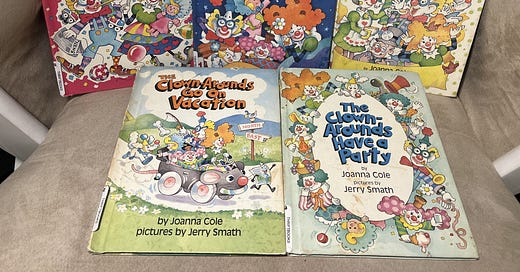



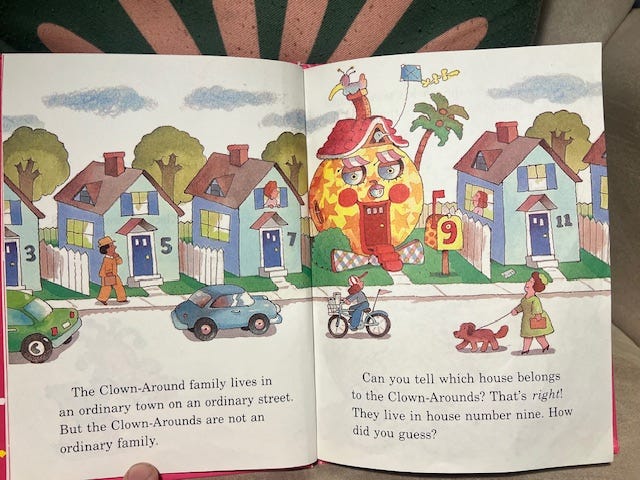

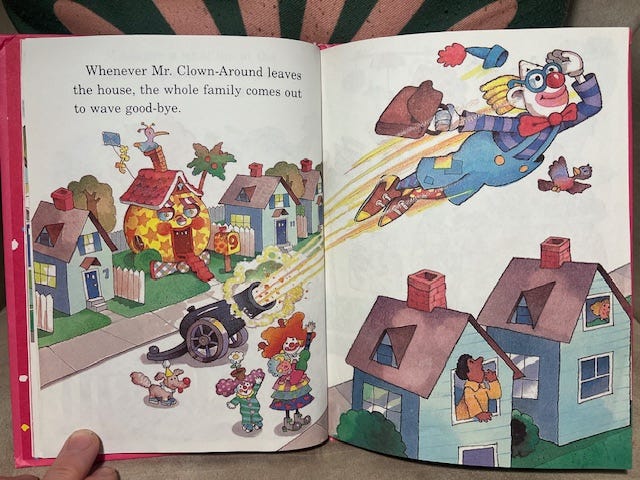
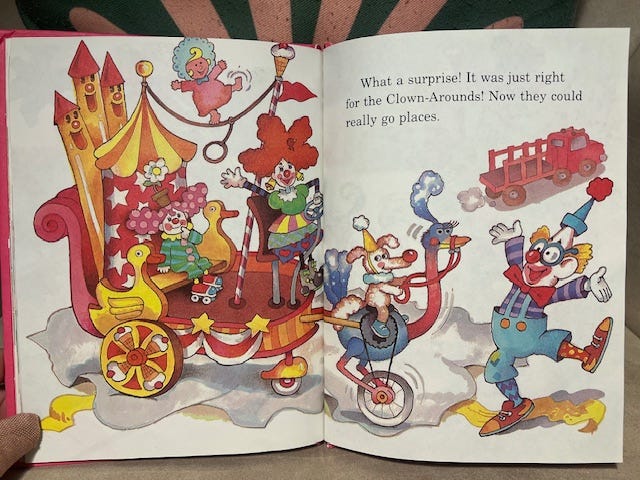
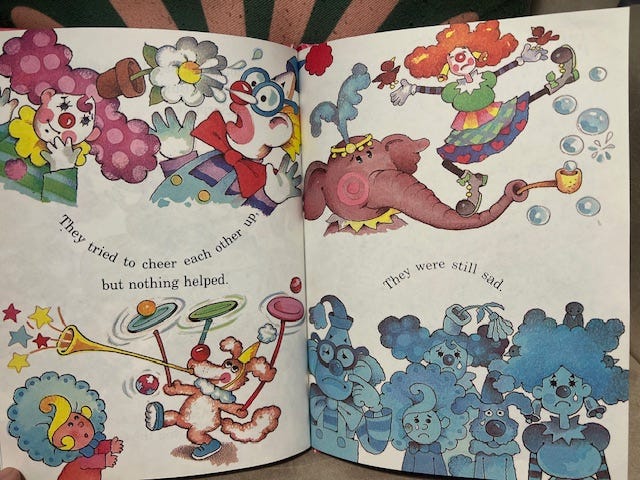
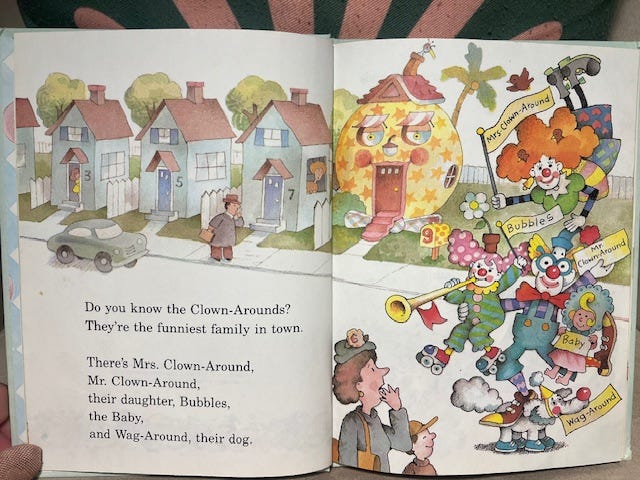
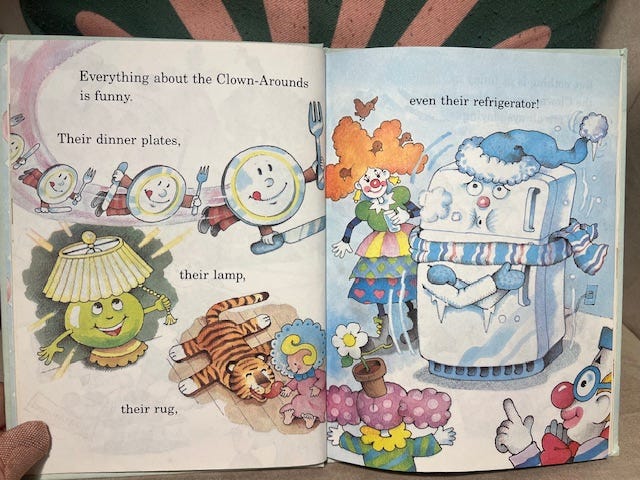
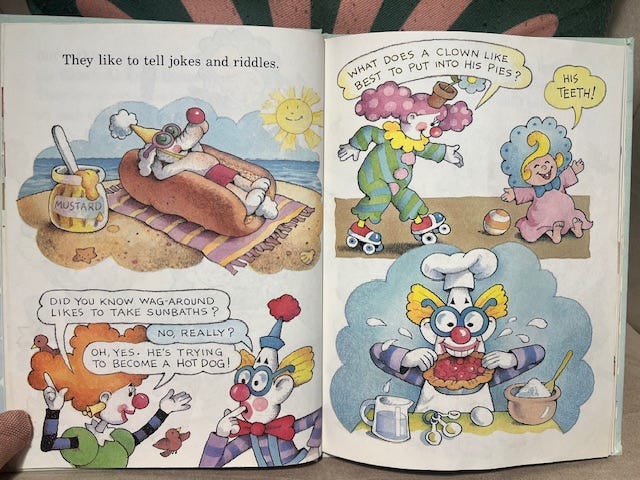
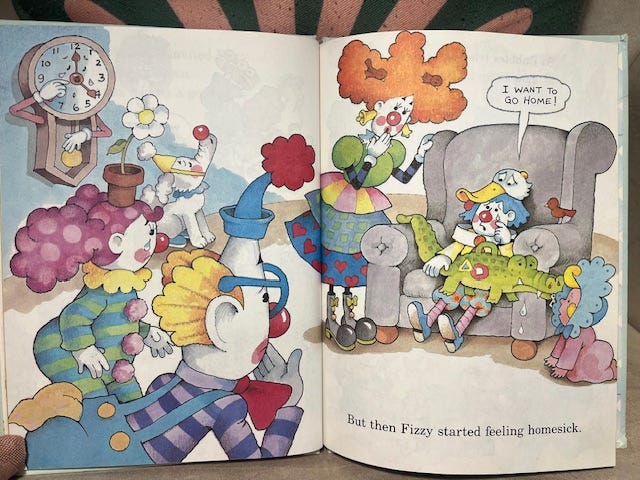
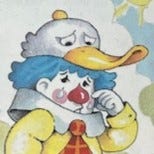
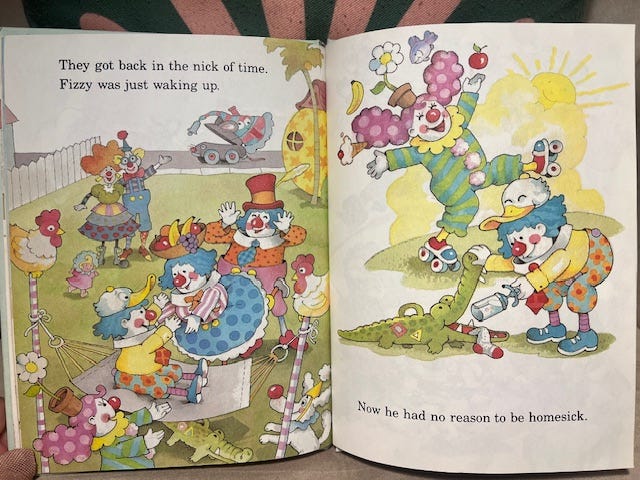
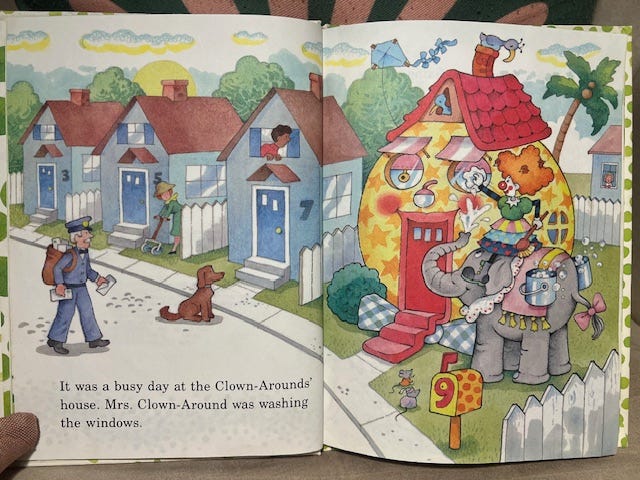
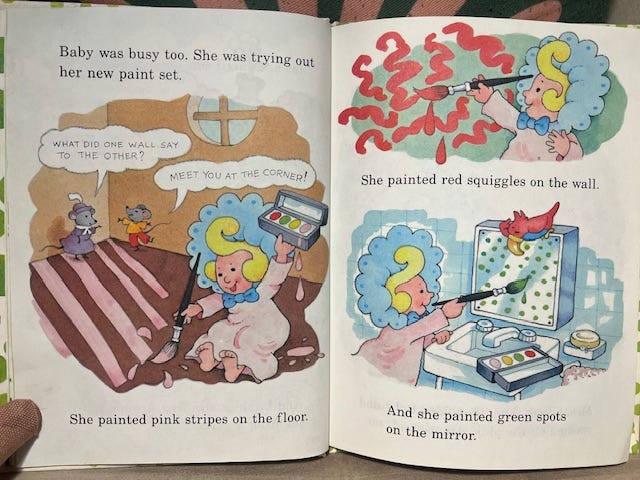
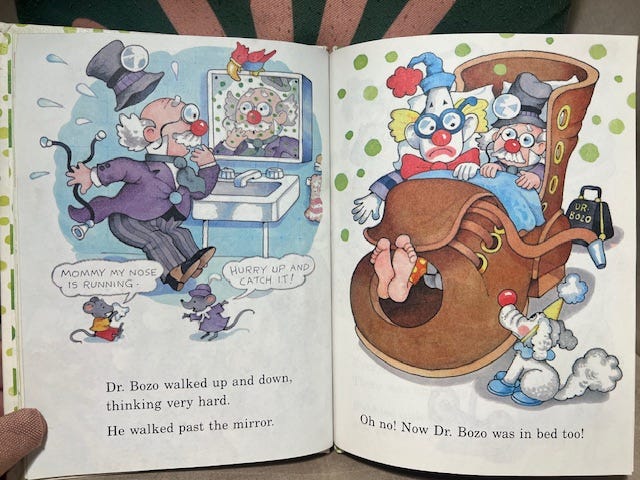
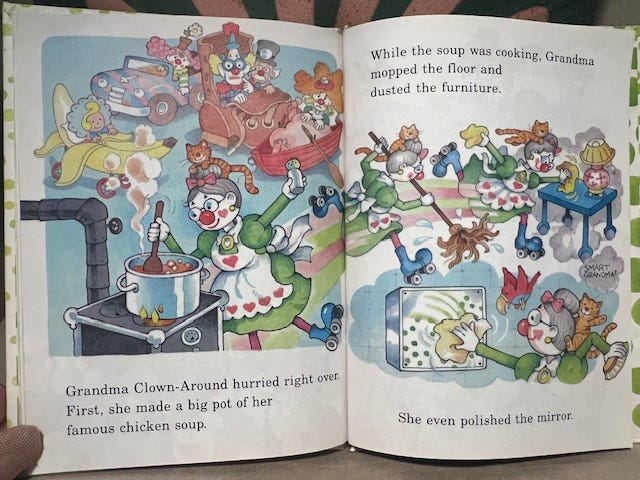
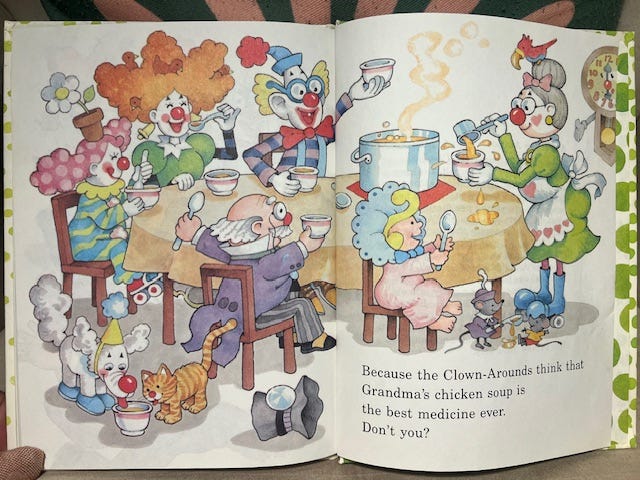
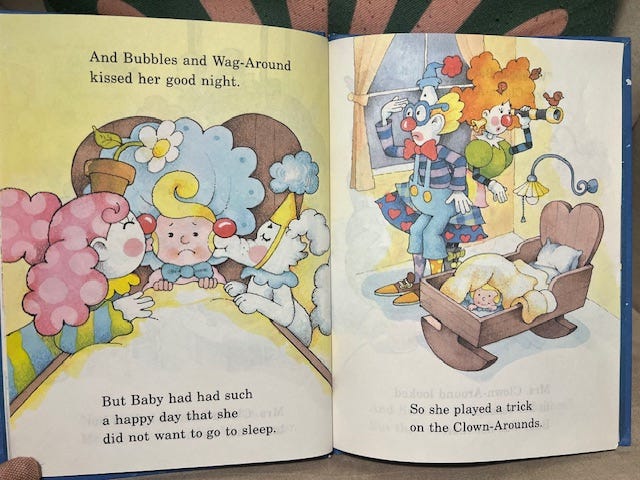
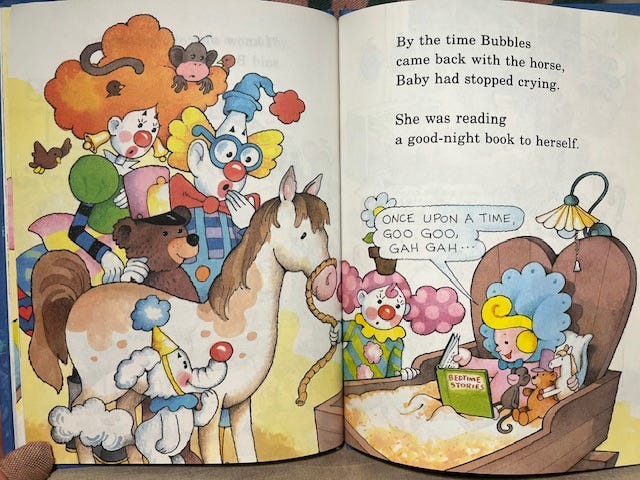
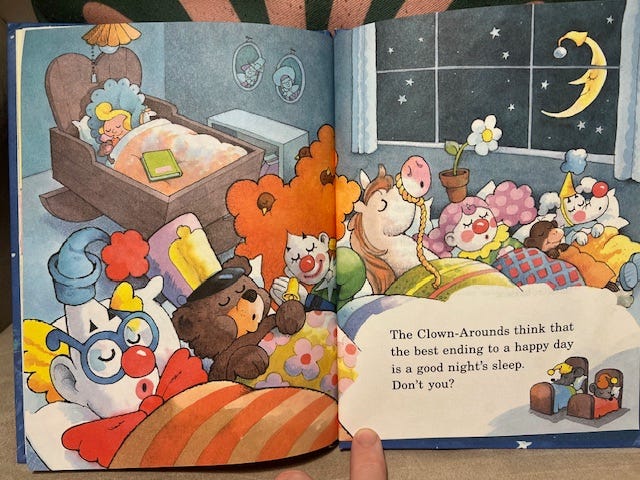
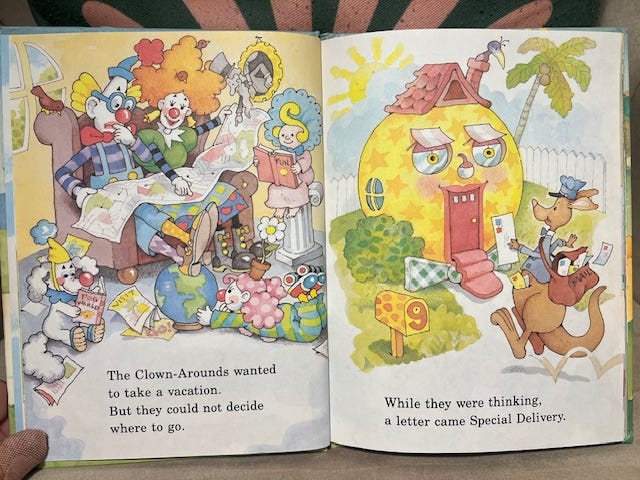
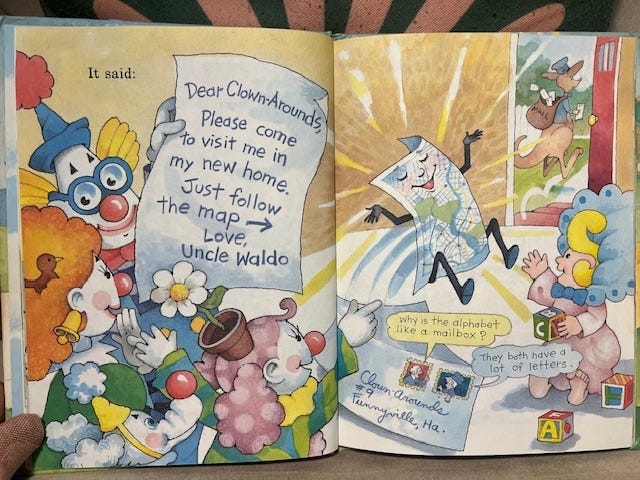
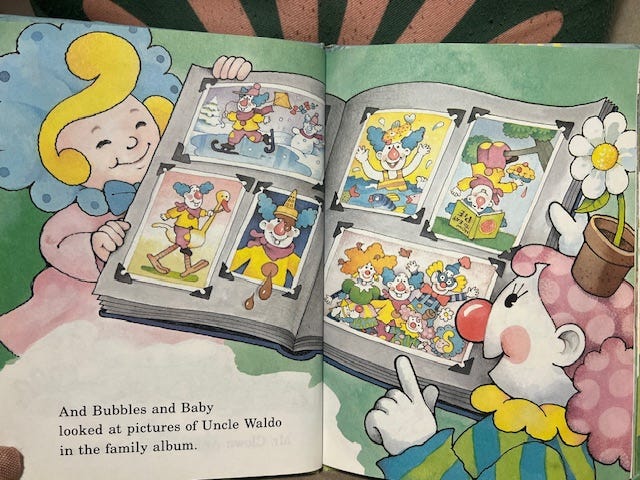
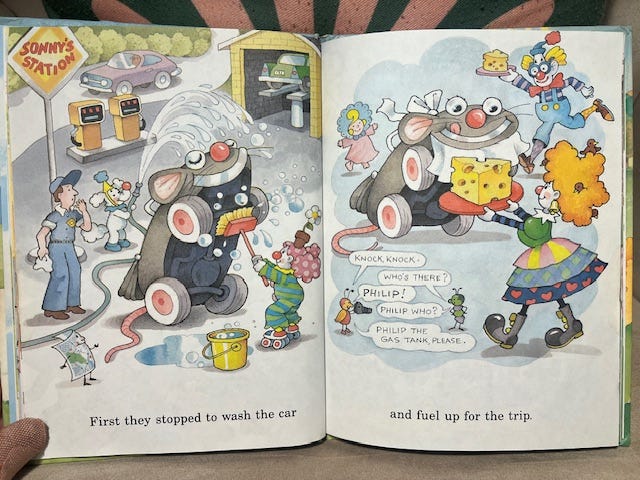
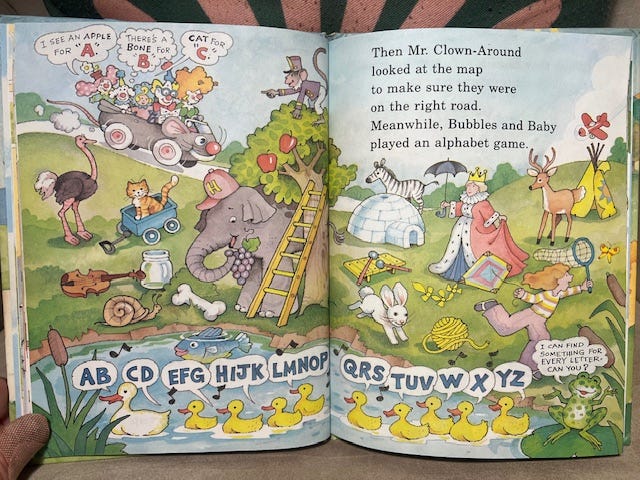
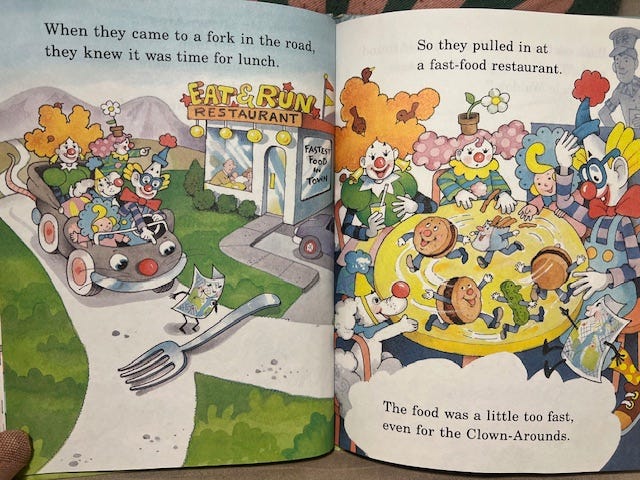
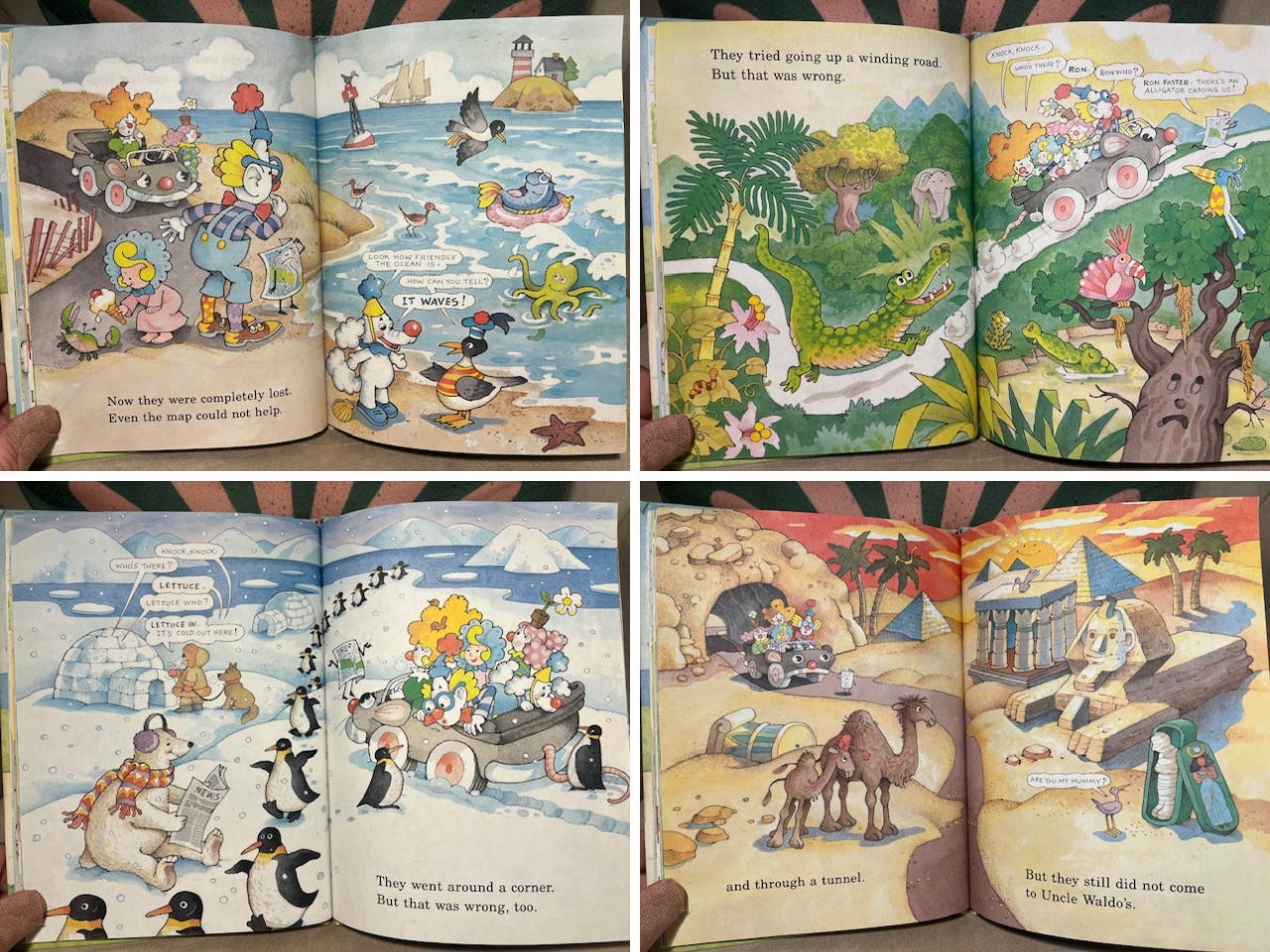
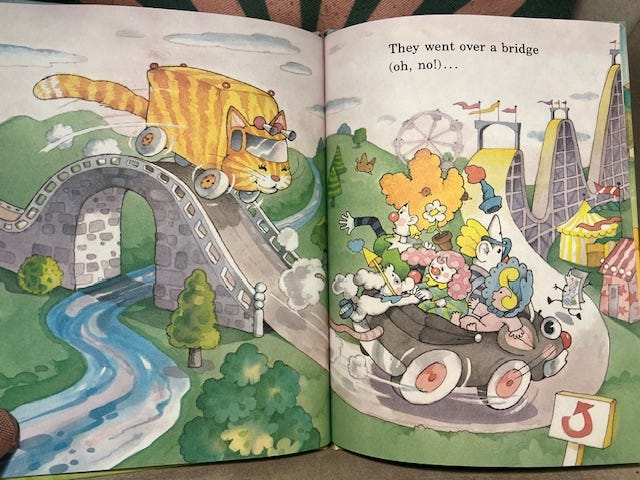
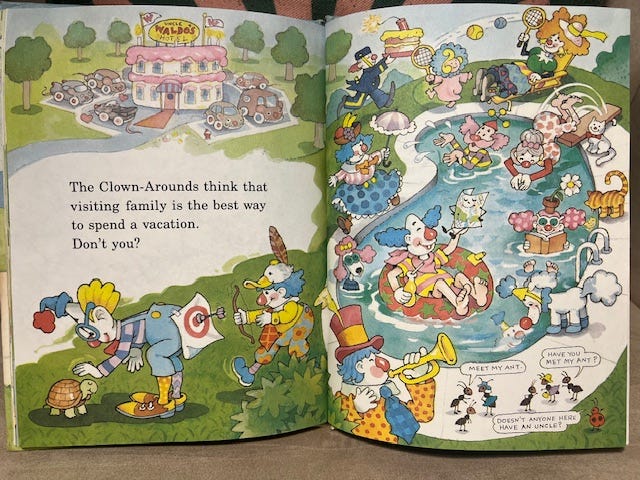





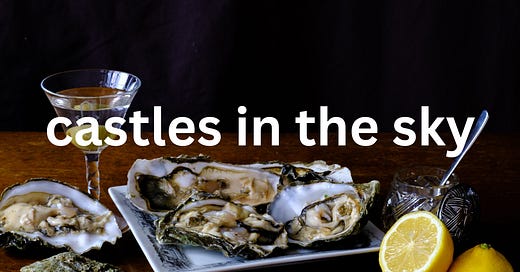

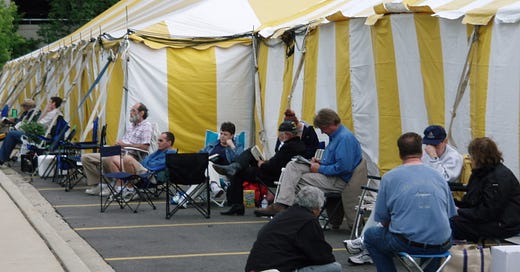

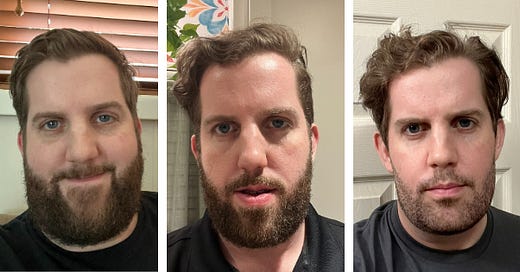

For some odd reason I was thinking about ‘the clown arounds’ this morning and googled it and found your essay. I was born in 1980 and owned this book as a little girl. My parents read this to me many many times and then to my own kids who are now 20 and 17. I guess I was thinking of this book because I want to make sure my parents still have it and wonder if my girls will be reading it to their own kids. I’m pretty sure we only had the first book, but I loved it! Another favorite I believe was called Henry the Duck where Henry had a very important date but an ant kept wreaking Havoc on him.
Awesome post. I often think about how it's easier to ponder the great mysteries of time and the universe than it is to respond patiently to a child, especially when they interrupt your pondering again and again--perhaps the really profound thing is the patience. Certainly it impacts time and history.